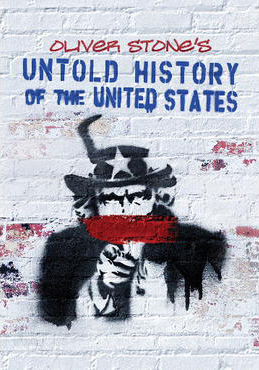 In the book and Showtime documentary series called The Untold History of the United States, director Oliver Stone and historian Peter Kuznick challenge the prevailing orthodoxies of traditional U.S. history textbooks. In the documentary series opening, Stone explains:
In the book and Showtime documentary series called The Untold History of the United States, director Oliver Stone and historian Peter Kuznick challenge the prevailing orthodoxies of traditional U.S. history textbooks. In the documentary series opening, Stone explains:
“When I was a young boy growing up in New York City, I thought I received a good education. I studied history extensively, especially American history. It made sense. We were the center of the world. There was a manifest destiny. We were the good guys.
“Well, I’ve traveled the world now. I continued my education as an infantrymen in Vietnam, made a lot of movies (some of them about history) and, when I heard from my children what they were learning in school, I was perturbed to hear that they were not really getting a more honest view of the world than I did.” Aided by the latest archival findings and recently declassified documents and building on the research of scholars, Stone and Kuznick construct a “People’s History of the American Empire.”
As the authors explain, “We don’t try to tell all U.S. history. That would be an impossible task. We don’t focus extensively on many of the things the United States has done right. There are libraries full of books dedicated to that purpose and school curricula that trumpet U.S. achievements. We are more concerned with focusing a spotlight on what the United States has done wrong — the ways in which we believe the country has betrayed its mission, with the faith that there is still time to correct those errors as we move forward into the twenty-first century.” [Based on publisher’s description.]
Trailer
Video Chapters
Chapter 1:
World War II The first chapter explores the birth of the American Empire by focusing on Franklin D. Roosevelt, Winston Churchill and Joseph Stalin. Through examination of key decisions during World War II, discover unsung heroes such as American Henry Wallace and explore the demonization of the Soviets.
Chapter 2:
Roosevelt, Truman & Wallace Highlights from the historical upset of Harry Truman replacing Henry Wallace as Roosevelt’s Vice President during his fourth term — this dramatic shift in leadership propelled the U.S. towards empire-building. Exploration of the relationship between the U.S. and the Soviet Union and the beginnings of the Cold War. The relationships between Roosevelt, Stalin and Churchill are an integral part of postwar Europe’s division at the Yalta conference.
Chapter 3:
The Bomb The strategies behind the U.S. atomic bombings of Japan are explored, as well as the new mythology that emerged from the war. The bombing haunted the Soviets and mistrust towards the Allies grew quickly. The consequences of beginning a process that could end life on the planet are examined.
Chapter 4:
The Cold War The equation changes: specific month-by-month causes of the Cold War. Highlights include Churchill’s Iron Curtain speech, the civil war in Greece and the Red Scare that prompts the rise of Joseph McCarthy, the House Un-American Activities Committee and the FBI.
Chapter 5:
The ’50s: Eisenhower, The Bomb & The Third World Eisenhower and John Foster Dulles replace Truman. Stalin dies but relations with the Soviet Union turn colder. The H-bomb and the doctrine of nuclear annihilation are explored, as are the Korean War and U.S. rearmament. McCarthyism grows and so does the ruthlessness of U.S. policy towards the Third World. Eisenhower emerges as a game changer.
Chapter 6:
JFK: To The Brink JFK and the Bay of Pigs; on the brink of total war during the Cuban Missile Crisis; early Vietnam; JFK’s attempts at peace with Khrushchev; JFK assassinated.
Chapter 7:
Johnson, Nixon & Vietnam: Reversal Of Fortune Cataclysm in Vietnam as the war reaches a turning point – there’s no going back. The betrayal by Richard Nixon.
Chapter 8:
Reagan, Gorbachev & Third World — Rise of the Right Carter’s dreams of change give way to Ronald Reagan’s secret wars in Afghanistan and Central America. Gorbachev emerges. Fresh opportunities for peace arise. The debate over Reagan’s legacy.
Chapter 9:
Bush & Clinton: Squandered Peace — New World Order Russia introduced to American Capitalism. U.S. goes to war in Middle East. New World Order shaped.
Chapter 10:
Bush II & Obama — Age of Terror George W. Bush’s doctrine of an “endless war” against terrorism manifests in the Department of Homeland Security, in Iraq and Afghanistan, and in a worldwide global Security State. The cannibalization of the U.S. economy continues. Obama and the destiny of the American Empire.
Prologue, Chapter A:
World War I, The Russian Revolution & Woodrow Wilson: Roots of Empire How did the United States become an empire? A look back at the election of 1900 and the Spanish-American War — climaxing with World War I and the Russian Revolution as the mother of the ensuing conflict between the British, Soviet, and newborn American Empire.
Prologue, Chapter B:
1920-1940: Roosevelt, Hitler, Stalin: The Battle of Ideas Franklin Roosevelt inherits a divided nation rife with conflict. Struggle leads to change in the United States, Hitler rises to power in Germany, and World War II pushes the U.S. and the Soviet Union toward an uneasy alliance.
Distributed by Warner Home Video. The Untold History website includes lessons for educators.







I am asking for this series for christmas. I have thirty years exposing the unexposed and proud to be on their black list. I just wanted to thank all of you for your dedication. I do feel some hope now after our election. It will be an up hill battle but now I believe we have a step.